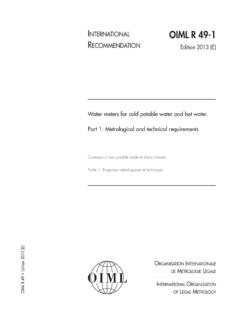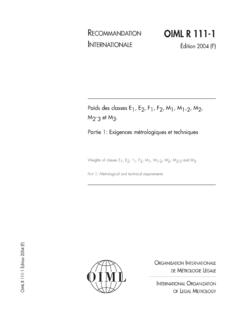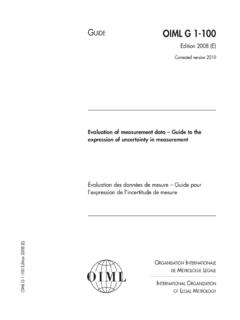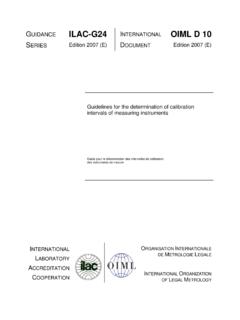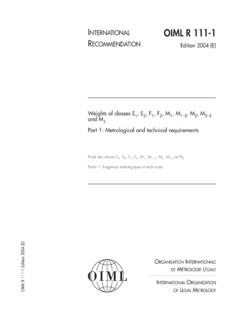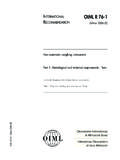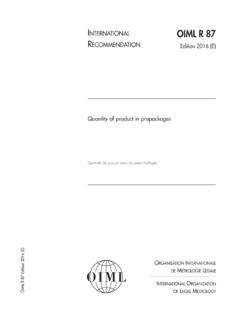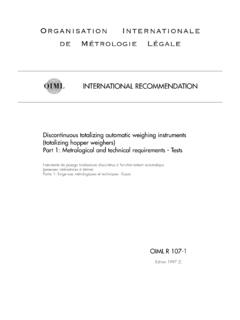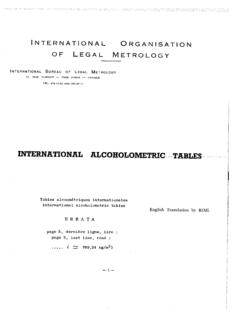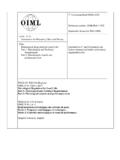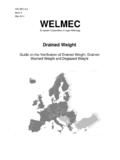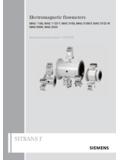Transcription of OIML R 76-1 Edition 2006
1 Non-automatic weighing instrumentsPart 1: Metrological and technical requirements - TestsInstruments de pesage fonctionnement non automatiquePartie 1: Exigences m trologiques et techniques - EssaisOIML R 76-1 Edition 2006 (E) oiml R 76-1 Edition 2006 (E)ORGANISATIONINTERNATIONALEDEM TROLOGIEL GALEINTERNATIONALORGANIZATIONOFLEGALMETR OLOGYINTERNATIONALRECOMMENDATIONOIML R 76-1: 2006 (E) 2 CONTENTS Foreword ..4 T Terminology ..5 General Construction of an Metrological characteristics of an instrument ..13 Metrological properties of an instrument ..15 Indications and Influences and reference Performance test.
2 20 Index of terms defined ..21 Abbreviations and 1 Scope ..25 2 Principles of the Recommendation ..25 Units of measurement ..25 Principles of the metrological Principles of the technical requirements ..25 Application of requirements ..26 Terminology ..26 3 Metrological requirements ..26 Principles of classification ..26 Classification of Additional requirements for multi-interval Auxiliary indicating devices ..28 Maximum permissible errors.
3 30 Permissible differences between Test standards ..32 Discrimination ..32 Variations due to influence quantities and time ..33 Type evaluation tests and 4 Technical requirements for a self- or semi-self-indicating General construction requirements ..41 Indication of weighing Analog indicating Digital indicating devices ..46 Zero-setting and zero-tracking devices ..47 Tare devices ..49 Preset tare Locking Auxiliary verification devices (removable or fixed).
4 54 Selection of weighing ranges on a multiple range Devices for selection (or switching) between various load receptors and/or load transmitting devices and various load measuring Plus and minus comparator instruments ..55 Instruments for direct sales to the public ..55 Additional requirements for price-computing instruments for direct sales to the public ..57 Instruments similar to those normally used for direct sales to the Price-labeling instruments ..59 Mechanical counting instruments with unit-weight receptor ..59 Additional technical requirements for mobile instruments ..59 Portable instruments for weighing road vehicles.
5 60 Modes of operation ..61 5 Technical requirements for electronic instruments ..61 General requirements ..61 Acting upon significant faults ..62 Functional requirements ..62 Performance and span stability tests ..63 Additional requirements for software-controlled electronic 6 Technical requirements for non-self-indicating oiml R 76-1: 2006 (E) Minimum sensitivity ..70 Acceptable solutions for indicating Conditions of construction ..71 Simple equal arm Simple 1/10 ratio beam.
6 72 Simple sliding poise instruments (steelyards) ..73 Roberval and B ranger instruments ..74 Instruments with ratio platforms ..74 Instruments with a load-measuring device having accessible sliding poises (of the steelyard type)..75 7 Marking of instruments and Descriptive markings ..76 Verification marks ..79 8 Metrological controls ..80 Liability to metrological Type approval ..80 Initial verification ..82 Subsequent metrological Annex A Testing procedures for non-automatic weighing instruments.
7 85 Administrative Compare construction with Initial examination ..85 Performance Influence factors ..94 Endurance Annex B Additional tests for electronic instruments ..100 General requirements for electronic instruments under test ..100 Damp heat, steady state ..100 Performance tests for disturbances ..101 Span stability test ..106 Annex C Testing and certification of indicators and analog data processing devices as modules of non-automatic weighing Applicable requirements ..108 General principles of testing.
8 109 oiml Annex D Testing and certification of digital data processing devices, terminals and digital displays as modules of non-automatic weighing instruments ..118 Applicable requirements ..118 General principles of testing ..119 oiml Annex E Testing and certification of weighing modules as modules of non-automatic weighing instruments ..122 Applicable requirements ..122 General principles of testing ..123 oiml Annex F Compatibility checking of modules of non-automatic weighing Weighing Separately tested load cells.
9 127 Separately tested indicators and analog data processing devices ..129 Compatibility checks for modules with analog Compatibility checks for modules with digital output ..132 Examples of compatibility checks for modules with analog output ..132 Annex G Additional examinations and tests for software-controlled digital devices and instruments ..137 Devices and instruments with embedded software ..137 Personal computers and other devices with programmable or loadable software ..137 Data storage devices ..138 Test Report Format ..139 3 oiml R 76-1: 2006 (E) Foreword The International Organization of Legal Metrology ( oiml ) is a worldwide, intergovernmental organization whose primary aim is to harmonize the regulations and metrological controls applied by the national metrological services, or related organizations, of its Member States.
10 The main categories of oiml publications are: International Recommendations ( oiml R), which are model regulations that establish the metrological characteristics required of certain measuring instruments and which specify methods and equipment for checking their conformity. oiml Member States shall implement these Recommendations to the greatest possible extent; International Documents ( oiml D), which are informative in nature and which are intended to harmonize and improve work in the field of legal metrology; International Guides ( oiml G), which are also informative in nature and which are intended to give guidelines for the application of certain requirements to legal metrology; and International Basic Publications ( oiml B), which define the operating rules of the various oiml structures and systems.
